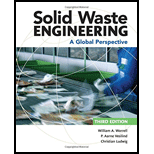
Solid Waste Engineering
3rd Edition
ISBN: 9781305635203
Author: Worrell, William A.
Publisher: Cengage Learning,
expand_more
expand_more
format_list_bulleted
Concept explainers
Question
Chapter 5, Problem 5.19P
To determine
The order and combination of any three of the unit operations to produce the highest recovery and purity of ferrous material.
Expert Solution & Answer
Trending nowThis is a popular solution!

Students have asked these similar questions
Membrane filtration, operated in a dead-end mode, is used to treat secondary effluent. If the HPC in the effluent increased from 5 org/L to 200 org/L, after an extended period of operation, estimate the number of broken fibers for the following conditions. The influent flowrate and organism count are 4000 m3/d and 6.7×107 org/L, respectively. The membrane bundle contains 5000 individual fibers. If the influent and effluent turbidity values under normal operation are 4 and 0.25 NTU respectively, estimate the increase in the effluent turbidity assuming the increase could be measured.
Complete the following problems dealing with rapid mix tanks and flocculation basins:1. Design a rapid mix tank for water at 50° F flowing at Q = 4.0 MGD for a typical process train ina drinking water treatment plant. Use a square tank with a depth 1.25 times the width, a designvelocity gradient G = 900 sec−1, and a hydraulic detention time τ = 30 seconds. Specificallydetermine:a. Rapid mix tank dimensions in feet and inches, to the nearest one inch.b. Input water horsepower (hp).c. Impeller rotational speed if a vane-disc impeller is used having a diameter half of the tankwidth and employing six flat blades and a baffled tank.2. Design a flocculation basin for water at 10°C flowing at Q = 49,200 m3/day for a typical processtrain in a drinking water treatment plant. The basin shall be a cross-flow, horizontal-shaft, paddlewheel type with an average velocity gradient of G = 26.7 sec−1, a detention time τ = 45 minutes,and a Gτ value of 50,000 to 100,000. Tapered flocculation shall be…
Whiskey (SG = 0.6 and ν = 5.0 x 10-7 m2/s) is drawn from a large tank through a smoothed, rubber hose as shown in the figure. The total length of the hose to be used is 9 m and the length of the hose to point A is 3.25 m. The intended extraction of whiskey is 10 L/s and minor losses at the entrance are to be neglected.
a) Calculate the smallest diameter (in 5 mm interval) required to achieve therequired flow using an iterative solution. Use an initial value of the friction factor, f0 = 0.020.b) Is the equation derived by Swamee and Jain applicable to solve the requireddiameter? Explain.c) Calculate the smallest gage pressure in the hose using the diameter (in 5 mminterval) solved.
Chapter 5 Solutions
Solid Waste Engineering
Ch. 5 - Prob. 5.1PCh. 5 - Prob. 5.2PCh. 5 - Prob. 5.3PCh. 5 - Prob. 5.4PCh. 5 - Prob. 5.5PCh. 5 - Prob. 5.6PCh. 5 - Prob. 5.7PCh. 5 - Prob. 5.8PCh. 5 - Prob. 5.9PCh. 5 - Prob. 5.10P
Ch. 5 - Prob. 5.11PCh. 5 - Prob. 5.12PCh. 5 - Prob. 5.13PCh. 5 - Two materials, A and B, are to be separated using...Ch. 5 - Prob. 5.15PCh. 5 - Prob. 5.16PCh. 5 - Prob. 5.17PCh. 5 - Prob. 5.18PCh. 5 - Prob. 5.19PCh. 5 - Prob. 5.20PCh. 5 - Prob. 5.21PCh. 5 - Prob. 5.22PCh. 5 - Prob. 5.23PCh. 5 - Prob. 5.24PCh. 5 - Prob. 5.25PCh. 5 - Prob. 5.26PCh. 5 - Prob. 5.27PCh. 5 - Prob. 5.28PCh. 5 - Which would separate a mixture of steel and...Ch. 5 - Prob. 5.30PCh. 5 - Prob. 5.31PCh. 5 - Prob. 5.32PCh. 5 - According to Figure 5-20, is ii possible to...Ch. 5 - using Figure 5-27, what is the advantage of the...
Knowledge Booster
Learn more about
Need a deep-dive on the concept behind this application? Look no further. Learn more about this topic, civil-engineering and related others by exploring similar questions and additional content below.Similar questions
- Two materials, A and B, are to be separated using two unit operations, 1 and 2. The feed has 10 tons/h A and 4 tons/h B. The split (fraction of material rejected by each operation) is given in Table P5-14. a. Which sequence of operations, (l?2) or (2?1), will yield the greatest recovery of material A? b. What will be the purity of material A using that sequence? c. What will be the efficiency of separation for the entire process train with regard to material A using the Worrell-Stesed equation?arrow_forwardLiquid alum is used as a coagulant and specific gravity of alum is 1.33. One gallon of alum weights 6.05 kg and contains 3.22 kg of dry alum. Determine;(a)The alumconcentration (b)What is the volume of liquid alum required in order to prepare a solution containing 20,000 mg/l of alum concentration with final volume of 100 mL? (c)The dosage concentration of 1 mL of stock solution in a 2000 mL Gator jarsample.arrow_forwardA technician recovered 221⁄2 pounds of refrigerant R-12 for disposal by emptying5⁄6 of a pound of R-12 from each of a number of portable dehumidifier units. Howmany dehumidifier units did the technician empty?arrow_forward
Recommended textbooks for you
 Solid Waste EngineeringCivil EngineeringISBN:9781305635203Author:Worrell, William A.Publisher:Cengage Learning,
Solid Waste EngineeringCivil EngineeringISBN:9781305635203Author:Worrell, William A.Publisher:Cengage Learning,

Solid Waste Engineering
Civil Engineering
ISBN:9781305635203
Author:Worrell, William A.
Publisher:Cengage Learning,